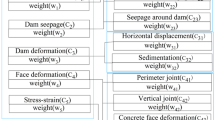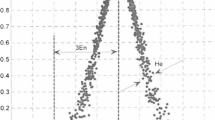Abstract
For better assessing the monitoring risk of adjacent buildings in the excavating environment, a novel model based on fuzzy cloud model (FCM) was developed. FCM is an organic integration of fuzzy theory (FT) and cloud model (CM), where FT is used to flexibly describe a quantitative process from complete attachment to the counter and CM is appropriately employed to eliminate the uncertainty of fuzziness and randomness during the gradation of evaluation factors. Firstly, a risk evaluation system is established by taking risk indicators as identification factors. Secondly, analytic hierarchy process (AHP) is utilized to calculate the weight of risk indicators, and FCM is applied for cloud computing of experts’ comments, with both the subjectivity of experts’ comments and the uncertainty of assessment indicators fully considered. Finally, the correlation between the calculated cloud results of each risk index and the risk standard cloud model is obtained to evaluate the integrated risk grade of adjacent buildings in the excavating environment. In addition, the results of the application using FCM in the foundation pit of Yue Bei Yuan (YBY) match well with the actual engineering situation. At the same time, three types of monitoring risks of YBY are discussed for further verifying the superiority of the evaluation method FCM. The results suggest that the model for monitoring risk of adjacent buildings in excavating environment is efficient and accurate. Moreover, the internal risks prove to be most significant.










Similar content being viewed by others
References
Boscardin MD, Cording EJ (1989) Building response to excavation-induced settlement. J Waterw Port Coast Ocean Eng 115(1):1–21
Chen TH, Wang MY, Xie DS, Zhang Y (2008) Risk identification and control in construction of metro station foundation pit. J Dis Pre Mitigation Eng 3:375–381
Chen J, Zhao S, Shao Q, Wang H (2012) Risk assessment on drought disaster in China based on integrative cloud model. Res J Appl Sci Eng Technol 4:1137–1146
Du XL, Zhang XF, Zhang MJ, Hou BW (2014) Risk synthetic assessment for deep pit construction based on evidence theory. Chin J Geotech Eng 36(1):155–161
Finno RJ, Voss. Jr FT, Rossow E, Blackburn JT (2005) Evaluating damage potential in buildings affected by excavations. J Geotechnic Geoenviron Eng 131:1199–1210
Gao, C.P., Zhang, D.M., Yan, J.Y., (2016) Risk analysis of existing shield tunnel caused by multistep unloading and re-loading of adjacent engineering activity. Eng J Wuhan Univ. 49(5), 708–713+786
GB 50497–2009, 2009. Technical code for monitoring of building excavation engineering. Beijing: China Planning Press.
Goyal, R., Goyal, T., Kaushal, S., & Kumar, H., 2019. Fuzzy AHP based technique for handover optimization in heterogeneous network. In Proceedings of 2nd International Conference on Communication. Computing and Networking, 16, 293–301.
Ilbahar E, Karaşan A, Cebi S, Kahraman C (2018) A novel approach to risk assessment for occupational health and safety using Pythagorean fuzzy AHP & fuzzy inference system. Safety and Science 103:124–136
Kubler S, Robert J, Derigent W, Voisin A, Le Traon Y (2016) A state-of the-art survey & testbed of fuzzy AHP (FAHP) applications. Expert Syst Appl 65:398–422
Kung GT, Juang CH, Hsiao EC, Hashash YM (2017) Simplified model for wall deflection and ground-surface settlement caused by braced excavation in clays. J Geotech Geoenviron Eng 133(6):731–747
Li DY (1997) Knowledge representation in KDD based on linguistic atoms. J Comput Sci Technol 6:481–496
Li DY (2000) Uncertainty in knowledge representation. Engineering. Science 2:73–79
Li D, Cheung D, Shi X, Ng V (1998) Uncertainty reasoning based on cloud models in controllers. Computers Mathematics with Applications 35:99–123
Li DY, Liu CY, Liu LY (2004) Study on the universality of the normal cloud model. Engineering Science 6:28–34
Li X, Liu X, Li CZ, Hu ZM, Shen GQ, Huang ZY (2018) Foundation pit displacement monitoring and prediction using least squares support vector machines based on multi-point measurement. Struct Health Monit 18(3):715–724
Li, L., 2019. Research on risk evaluation of PPP project based on AHP-cloud model. MD thesis. Beijing Jiaotong University. Beijing.
Liu B, Wang KQ, Huang M (2015) Research on fuzzy hierarchical risk assessment of metro deep excavation pit. Chin J Undergr Space Eng 11:257–264
Liu, N.W., Chen, Y.T., Gong, X.N., Yu, J.T., 2018. Analysis of deformation characteristics of foundation pit of metro station and adjacent buildings induced by deep excavation in soft soil. Rock and Soil Mech. 40(4), 1515–1525+1576.
Long L, Li ZD (2020) An assessment model of monitoring risk in deep excavation based on fuzzy theory. Indoor Built Environ 29(2):221–229
Luo, H., 2016. A collapse occurred at a construction site in Daning. http://news.hexun.com/2016-03-17/182812828html. 2016–03–17.
Ou CY, Teng FC, Wang IW (2008) Analysis and design of partial ground improvement in deep excavations. Comput Geotech 35(4):576–584
Saaty TL, Tran LT (2007) On the invalidity of fuzzifying numerical judgment in the Analytic hierarchy Process. Math Comput Model 46:962–975
Saaty TL, Vargas LG (1979) Estimating technological coefficients by the analytic hierarchy process. Socioecon Plann Sci 13(6):333–336
Sandanayake M, Zhang GM, Setunge S (2016) Environmental emissions at foundation construction stage of buildings - two case studies. Build Environ 95:189–198
Tseng KC, Hwang CS, Su YC (2011) Using cloud model for default voting in collaborative filtering. J Converg Inf Technol 6:68–74
Unal O, Demir F, Uygunoglu T (2007) Fuzzy logic approach to predict stress-strain curves of steel fiber-reinforced concretes in compression. Build Environ 42:3589–3595
Wang LF, Xu SB (1990) Introduction to the analytic hierarchy process. China Renmin University Press, Beijing
Wang S, Qin Y, Liu HQ, Chen YY, Yu QZ (2019) Analysis and treatment on a foundation excavation collapse. Constr Technol 48(07):18–20
Wang, X.C., Zhang, T.Y., Liu, X., 2018. Cause of accident of a deep base pit supporting project in Shenyang. Journal of Shenyang University(Natural Science). 30(5), 401–408.
Wei XJ, Deng ZQ, Wei G, Ding Z (2008) Safety evaluation of foundation pits by extension assessment method combined with entropy law. Chin J Geotech Eng 30:672–676
Xiao XC, Yuan JR, Zhu YF (2009) Causation analysis of the collapse on Singapore MRT circle line lot C824 (Part I) - project background and process of collapse. Mod Tunneling Technol 46(5):66–72
Xu YQ, Chen XL, Cao DB (2018) Compatibility test method in minimal samples situation with two samples. Acta Aeronautica Et Astronautica Sinica 39(5):145–151
Yan FF, Wei CP, Ge SN (2018) Entropy measures for dual hesitant fuzzy sets and their application of multi-attribute decision-making. Math Practice Theory 48(17):131–139
Yang YH, Lv, Y.j. (2018) Consistency check of fuzzy judgement matrix. Statistics and Decision 34(4):78–80
Yang WD, Yang D, Xie QM (2018) Study on slope risk assessment method based on cloud model and its application. Journal of Huazhong University of Science and Technology (natural Science Edition) 46(4):30–34
Ye SH, Li DP (2019) Monitoring and simulation analysis of deep and large foundation pit excavation in complex environment. Chin Civil Eng J 52:117–126
Yoo C, Lee D (2008) Deep excavation-induced ground surface movement characteristics-a numerical investigation. Comput Geotech 35(2):231–252
Zadeh LA, Fu KS, Tanaka K, Shimura M, Negoita CV (1975) Fuzzy sets and their applications to cognitive and decision processes. Automatic Control IEEE Transactions on 22(6):999–1000
Zhang J, Tang J, Pei F (2012) A method for network security risk assessment and decision-making based on the cloud model. J Converg Inf Technol 7:146–153
Zhang LM, Wu XG, Ding LY, Skibniewski MJ (2013) A novel model for risk assessment of adjacent buildings in tunneling environments. Build Environ 65(7):185–194
Zhang XX, Ge BF, Tan YJ (2016) A consensus model for group decision making under interval type-2 fuzzy environment. Frontiers of Information Technology & Electronic Engineering 17(3):237–249
Zhang, L.M., 2012. Study on risk management of deep foundation pit monitoring project. PhD thesis. Tianjin University. Tianjin.
Author information
Authors and Affiliations
Corresponding author
Ethics declarations
Conflict of interest
The authors declare no competing interests.
Additional information
Responsible Editor: Amjad Kallel
Supplementary Information
Below is the link to the electronic supplementary material.
Rights and permissions
About this article
Cite this article
Long, L., Li, Z., Li, L. et al. A novel assessment model for monitoring risk of adjacent buildings in excavating environment. Arab J Geosci 15, 176 (2022). https://doi.org/10.1007/s12517-022-09451-2
Received:
Accepted:
Published:
DOI: https://doi.org/10.1007/s12517-022-09451-2




